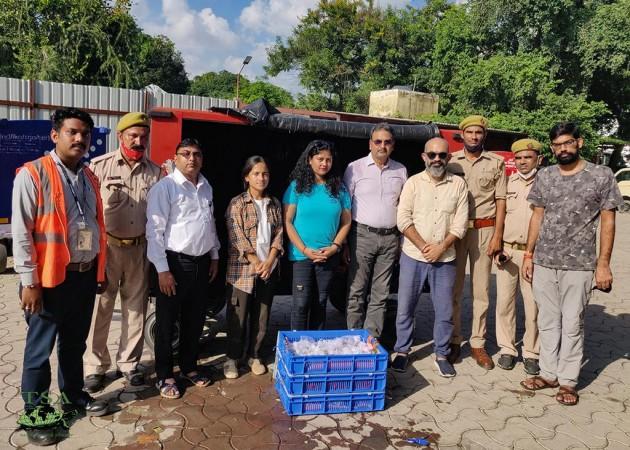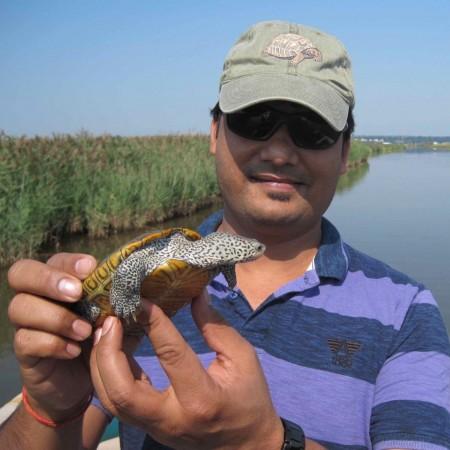In August 2021, two citizens of Hyderabad were apprehended by law enforcement officers of the Telangana Forest Department for attempting to sell the protected turtles to aquarium shops.
The accused confessed to poaching the turtles from the Gomti River near Lucknow, Uttar Pradesh. Following their seizure, the turtles were shifted to the Nehru Zoological Park for care until they could be repatriated.

Turtle Survival Alliance (TSA), an organization dedicated to conservation and rescue efforts of the crucial yet neglected species, announced in a statement this week, the rescue and return of 266 native Indian freshwater turtles namely Indian Roofed Turtles (Pangshura tecta) and Pink-ringed Tent Turtles (Pangshura tentoria circumdata).
The operation, first-of-its-kind interstate repatriation, was successful with the joint efforts of Nehru Zoological Park, Telangana Forest Department, Uttar Pradesh Forest Department, and Air India.

On Sunday, September 19, 2021, TSA India Program partner Air India flew the turtles from Hyderabad to Lucknow in specially designed cargo containers.
Following an eight-hour flight, the turtles arrived in their home state of Uttar Pradesh, where they were further transported to the joint Uttar Pradesh Forest Department/TSA India Program Laboratory for Aquatic Biology at the Kukrail Gharial and Turtle Rehabilitation Centre. After being observed for diseases for a month, the turtles will be released into a protected area of the Gomti River.
Not pets but crucial wildlife
Dr. Shailendra Singh, TSA India Program Head who was recently awarded the Behler Turtle Conservation Award spoke to IBTimes about the crucial role of turtles.
"Turtles are a crucial part of our ecosystem. It is one of the only species that possess the aquatic as well as the terrestrial system of living. They are responsible for recycling a lot of nutrients, they burrow; so they kind of keep the ecosystem dynamic. I tell people, they are the vultures of the aquatic ecosystem. They are great indicators of wetland health and help in understanding signs of climate change," he said.

India is third in the world in terms of freshwater turtle and tortoise diversity with 41 native species and subspecies. More than half are listed as 'threatened' by the International Union for Conservation of Nature (IUCN). The Indian Roofed Turtle is listed as a Schedule 1 species under the Indian Wild Life Protection Act, 1972, giving them absolute protection from collection and trade.
Turtles as climate change indicators
"Climate change can be easily predicted with the turtle population. Lots of people don't know that the turtle population is based on the temperatures of its current environment which means that if the temperature is less, there will mostly be male turtles in the nest.
Higher temperature around the nest indicates that more female turtles will be born," explained Dr. Singh adding that such tiny observations can say a lot about wetland health and how sustainable it is. Apart from turtles, he also works closely with river dolphins, land tortoise species, and gharials.
A user-friendly app that talks turtles
Given their docile nature and tiny size, turtles are often eyed as domesticated pets but closed enclosures aren't where they belong. In India, many Hindu temples are known to prison the species in temple ponds owing to its significance in Hindu mythology.
TSA is not just against keeping turtles at home but also works closely with temples to generate awareness about the reptiles belonging out in nature and not in cemented ponds where they cannot mimick their true nature. Earlier this year, Dr. Shailendra Singh's team signed a unique MoU with temple authorities in Northeast India especially Assam where temple waters are a shaky ground for threatened turtle species.
Kurma App
TSA's Kurma app is a citizen science initiative to record the turtle biodiversity in India. Users can report turtle sightings, identify the species, obtain details of assistance facilities that can be reached out to for help across the country. It also informs how many rescue efforts have been made and how people are the most important key in such conservation efforts.

















